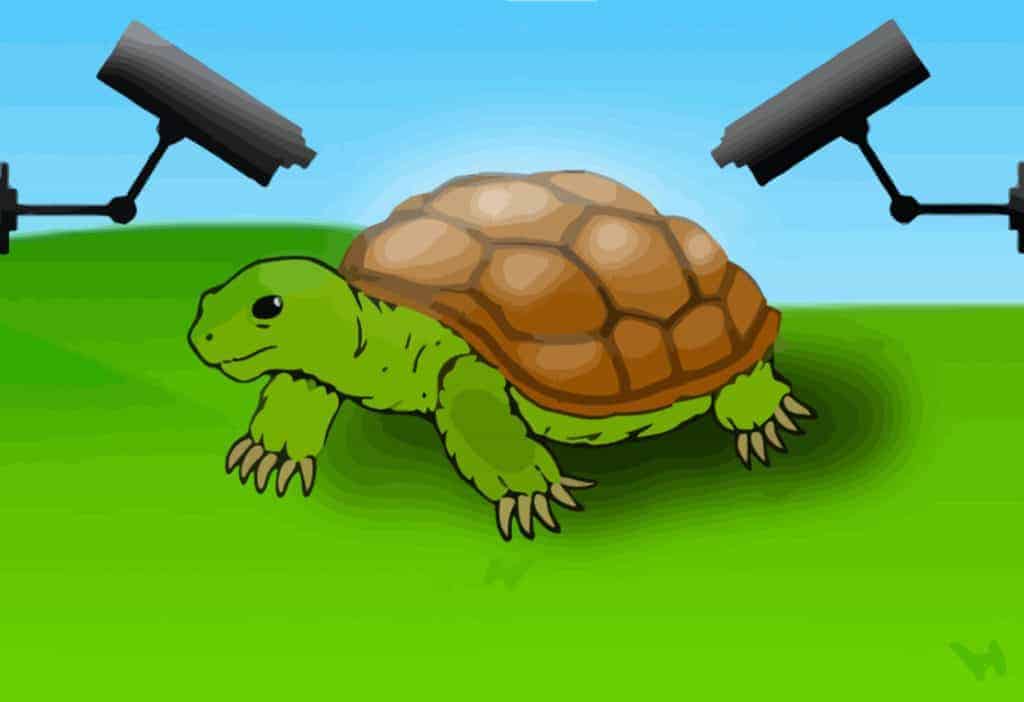
Being the weird and wonderful animals they are unfortunately makes tortoises a target for thieves, especially older and larger specimens, given their significant monetary value.
It is important to stress that tortoise theft is a relatively uncommon experience among tortoise owners, so there’s no need to panic unnecessarily. In the UK there are usually reports of between 30 and 50 thefts per year, which is not a huge number in the grand scheme of things.

It is however prudent to have some sort of strategy to keep your tortoise secure from thieves to save yourself from undue heart ache should a thief contemplate stealing him or her.
How Can I Safeguard My Tortoises?
The most important thing you can do to keep your tortoise out of the hands of would be tortoise nappers is really quite simple:
Don’t advertise the fact you have a tortoise, or tortoises.
Online Prying Eyes
Friends and family aside, the fewer people who know about your tortoise the better. You’ve probably heard stories of people who scrawl all over facebook how wonderful a time they’re having on holiday, and then wonder why their house gets burgled in their absence.
Well the same is true of tortoises, if you’re posting pictures of your prize 50 year old Indian Star all over your social media accounts then you run the risk of picking up the wrong kind of attention.
Sure you might be able to trust all of your friends, but can you really trust your friends’ friends and so on?
Trust me, it’s not worth the risk. If you do want to share pictures online, limit your enjoyment of your tortoise to truly private forums such as shared online photo albums.
Real World Prying Eyes
Of course it’s not just the online world that poses a potential threat to your shelled friend, just having your tortoise too readily on display to passers by or untrustworthy neighbours can be a potential threat.
Don’t have your tortoise table or vivarium close to a window at the front of your house where it can be seen from the street, and if you’ve got any concerns about who might be peering over into your garden or yard, see what measures you can take to keep your tortoise and their outdoor enclosure out of sight.
It can be more of a challenge to keep your tortoises out of sight outdoors as you want to be able to take full advantage of exposing them to natural light, so the last thing you want to do is completely cover up their enclosure. A bit of creativity is needed to achieve a balance between security and a healthy tortoise.
What Particular Deterrents Can I Use?
Let’s look in a little more detail at what you can do to safeguard your tortoise besides keeping your them out of sight and not advertising their presence too strongly.
Tortoise Kept Indoors
Besides keeping your tortoise out of sight, you should do all the things you would normally do to keep your house secure, making sure all doors and windows are locked when the tortoise is left unattended.
Apparently the average burglary lasts something like 10 minutes, which makes sense when you think about it. No criminal worth his salt wants to be at the scene of the crime any longer than he needs to be, or else risk prosecution.
Armed with this knowledge your task is to make stealing your tortoise as difficult as possible should a thief somehow infiltrate your home. If you can stall them for just a few minutes more than they would normally be comfortable with there’s a good chance they’ll instead choose to leave empty handed.
The next line of defence is the tortoise enclosure itself. Keeping a lock on this might seem a little extreme, and of course it won’t stop a determined thief, but like I said, it might stall them just enough. It doesn’t need to be anything too heavy duty as chances are the enclosure itself won’t be that heavy duty.
Another really useful tool that’s readily available these days is a WIFI camera. You can pick these up for under £50 ($65), position them anywhere in your house near to a power outlet, and away you go. I’ve personally got one that I use for a variety of purposes, from monitoring my baby son at night time to my tortoise in the garden during the summer.
They’re cheap enough that you can get several of them permanently rigged up should you choose. It’s well worth trying one out to begin with in any case.
Tortoises Kept Outdoors
Your back yard is an easier target than inside your home, so here your security measures need to be a bit more heavy duty than they would be indoors.
Chiefly this means your enclosure needs to be as tamper proof as you can make it, and the lock you use needs to be much more sturdy. Personally I would advocate using a ‘hasp and staple’ type latch with a nice big padlock on it.
You should also make sure your enclosure is securely fastened to the ground, ideally with its uprights set and concreted into the soil so that it can be lifted up or turned over.
The mesh you have over your enclosure should ideally be a sturdy fence or chicken wire mesh. Again, this won’t deter a person armed with a pair of sharp wire cutters, but if you can at least deter the casual opportunist that’s better than nothing.
You can also install an alarm and/or infrared sensors on your enclosure to pick up the movements of any nefarious individuals. Naurally you’ll want to position this equipment such that the tortoise itself can’t accidentally set it off by mistake!
Besides the enclosure other things you can do to keep your tortoise safe outdoors include:
- Having tall, sturdy fencing all round your yard or garden. When I say tall, at least 6’ so that it can’t easily be scaled by an intruder. For maximum benefit put some sort of anti climb feature on top of the fence such as the spikes usually used to deter cats.
- As well as/instead of fencing, large dense shrubs or trees that both block the view of those in the street, whilst not preventing access are also effective. Again though, don’t make these so imposing that they block out the sunlight for your tortoise
- CCTV. It might be prudent to use a dedicated outdoor CCTV camera, something more heavy duty to the WIFI variety I use indoors, both as a deterrent and means of capturing evidence should the worst happen. It’s always a bit of a gamble having a CCTV camera on display outside of your house, as you could argue that it actually draws in unwanted attention rather than taking it away. So think carefully if you want to pursue this method.
- Security lighting is a fairly common feature in many homes for many reasons, so this is a good choice to startle any would-be thieves during the night.
Cataloging Your Tortoise
Should all of the above methods fail and your tortoise is still taken, it is useful to make a note of any information you can that will help to identify your tortoise. This information can then be passed onto the police or relevant authorities to aid with their investigations.
Most importantly this involves getting clear photographs from every angle, each side, back front, top and bottom of the tortoise. This will give a clear view of every identifying mark and unique pigmentation on the shell and plastron. Just like our own fingerprints, no two tortoise’s markings are the same, so this is a definitive method of identification.
Be sure to note on the photographs when they were taken, and store them in a secure location, whether in soft or hard format. If you keep them in a soft format only then be sure to keep a back up in a separate location.
Some people suggest sticking an identification tag to the tortoise with an adhesive like an epoxy resin. Personally I wouldn’t do this because I don’t believe putting any sort of chemical on your tortoise’s shell is a good idea. After all the shell is as much a living part of the tortoise as the rest of it, so you’ll want to make sure you don’t damage it in any way.
Besides, if a thief really wanted to they could remove any stuck on panel or other distinctive mark you put on the tortoise, and probably with little regard for the tortoise in doing so.
Microchipping
If you own an Annexe A tortoise then by law your tortoise should have already been microchipped in order to be sold to you in the first place. However this only applies if they were at least 100mm long at the time of purchase. Smaller specimens and Annexe B tortoises do not require microchipping by law.
However most good reptile vets offer a micro chipping service should you feel the need.
Of course microchipping your tortoise won’t prevent it from being stolen, and it won’t really be of much use to try and track them down, unless the person who stole the tortoise plans to sell it on via legitimate channels that flag up the tortoise as missing, but this is probably unlikely.
None the less for less than £50 or $65 it can be a useful addition to your other preventative measures, just on the off chance that it does prove to be the piece of the puzzle you one day need to track down your missing tortoise.
Which Tortoises are Most at Risk From Theft?
To the opportunist thief any tortoise is an easy target, but it’s fair to say the larger the specimen the more appealing, because after all ‘bigger is better’.
If on the other hand you’re unlucky enough to be targeted by someone who really knows their tortoises and you’ve got a specimen from an expensive species such as an Indian Star Tortoise or a Leopard tortoise, especially an older one, then they will be a particular target for determined thieves.
In monetary terms you’ll have several thousand pounds worth of tortoise on your hands so it’s of particular importance to keep them as secure as you possibly can.



